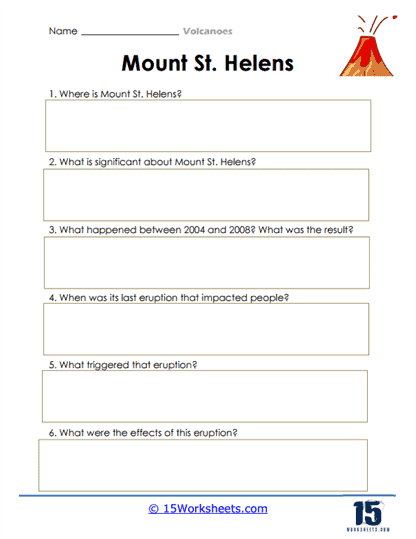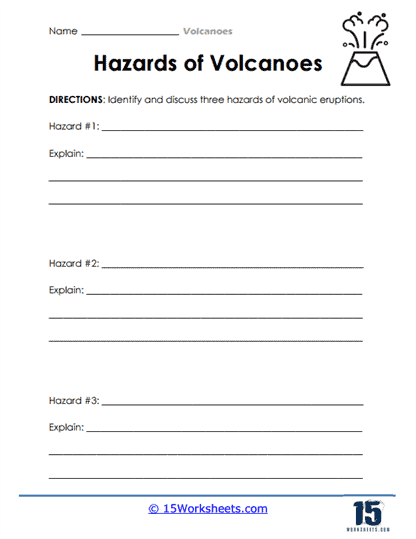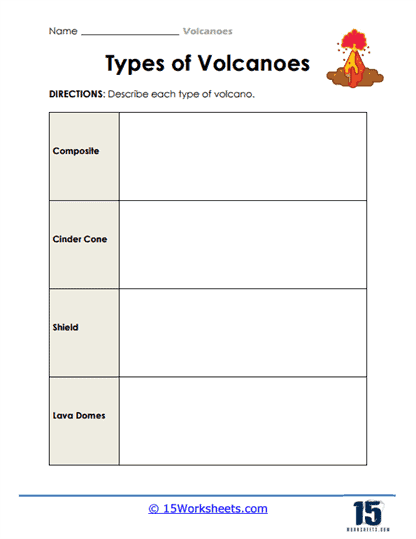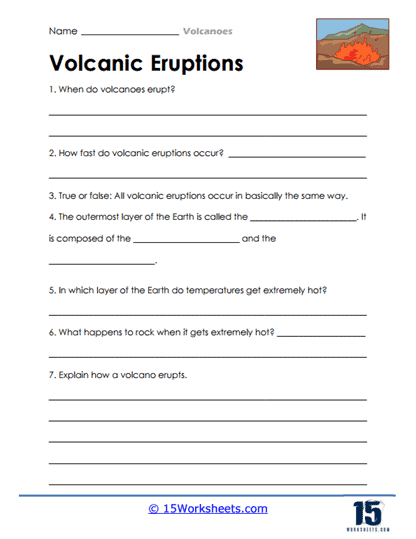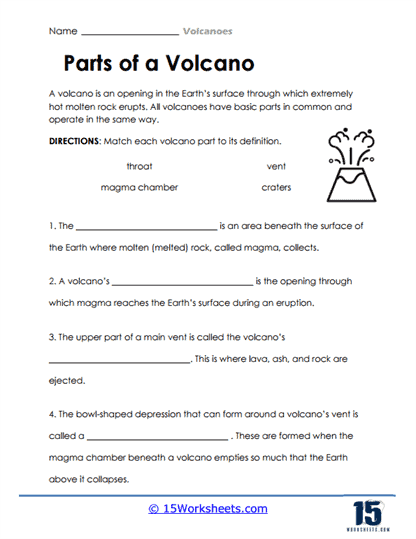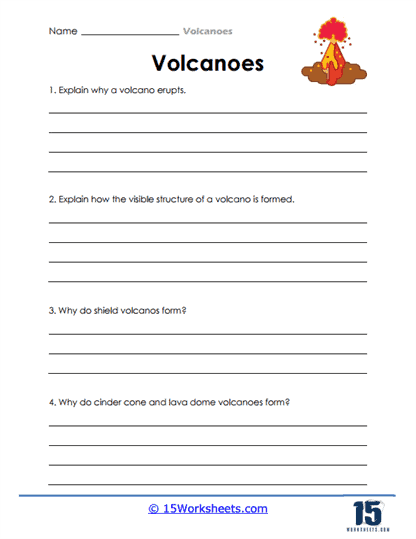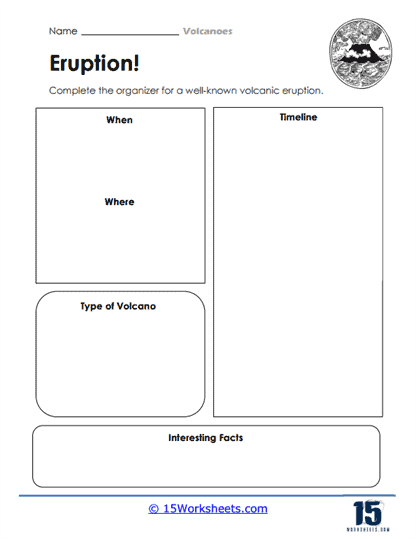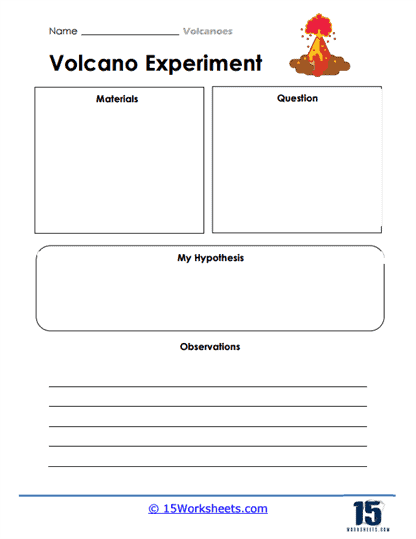Volcanoes Worksheets
About These 15 Worksheets
This collection of volcano worksheets provides a comprehensive, engaging, and structured approach to learning about the science behind volcanoes. It covers a broad range of skills and tasks that help students not only understand the geological processes involved in volcanic eruptions but also reinforce critical thinking, problem-solving, and vocabulary skills. Here’s a breakdown of the skills students will develop and the tasks they will complete using these worksheets:
The first set of worksheets focuses on explaining why and how volcanoes erupt. Through reading comprehension exercises, students will learn about magma, volcanic activity, and the earth’s layers that contribute to the eruption process. These worksheets prompt students to explore questions like “What is a volcano?” and “How do volcanoes create new land?” This not only enhances their reading comprehension but also introduces them to fundamental scientific concepts such as plate tectonics and magma movement.
Another worksheet delves into active volcanoes and the distinction between active and dormant volcanoes. It teaches students to understand how scientists monitor volcanoes and predict eruptions. By answering questions about the number of active volcanoes on Earth and how they shape the landscape, students connect real-world phenomena with the theoretical knowledge they are gaining. This worksheet emphasizes the ongoing research into volcanic activity and the importance of geologists’ work in predicting natural disasters.
The “Volcano Word Problems” worksheet integrates math into the science of volcanoes, challenging students to solve problems related to volcanic eruptions. These problems involve calculating distances, predicting future eruptions, and working with time intervals. For example, students may calculate the rate of lava flow or determine the area of evacuation based on the radius of volcanic activity. This section encourages students to apply math in practical scenarios related to volcanology, thus strengthening their problem-solving skills.
A diagram-based worksheet introduces students to the various parts of a volcano, including terms like lava, magma chamber, central vent, and crater. Students are tasked with labeling these parts on a diagram, which reinforces their understanding of volcanic structure in a visual manner. This worksheet sharpens their spatial awareness and scientific vocabulary as they match definitions to volcanic features.
Vocabulary development is a significant component of this collection, with worksheets that require students to match terms like “magma,” “eruption,” and “caldera” to their definitions. This builds students’ science-specific language skills, enabling them to speak and write about volcanoes more confidently. The worksheet includes a mix of definitions related to volcanic phenomena and geological terms, making it essential for solidifying their understanding of key concepts.
A “True or False” worksheet serves as a quick way to assess students’ grasp of volcano-related facts. Statements cover a range of topics such as the types of volcanic rocks, the characteristics of volcanic eruptions, and the differences between various types of volcanoes. This worksheet allows for a straightforward evaluation of students’ retention and understanding of the material covered.
Some worksheets include open-ended questions that ask students to explain why volcanoes erupt, how volcanic structures form, and the differences between types of volcanoes (such as shield volcanoes and lava domes). These tasks encourage students to think critically and express their understanding in their own words, improving their writing and explanatory skills.
The Story of Volcanoes
A volcano is far more than just a picturesque mountain. It’s a direct portal into the Earth’s molten core, revealing the fiery forces that lie beneath the surface. Imagine it as a giant pressure valve, allowing molten rock, or magma, from deep within the Earth’s mantle to surge upward, breaking free in an awe-inspiring spectacle of lava, ash, and steam. These eruptions not only captivate us with their beauty and power but also serve as a stark reminder of the dynamic forces continually shaping and reshaping our planet’s surface.
Volcanoes typically form along tectonic plate boundaries, where the Earth’s crust is fractured and more easily allows magma to escape. The Earth’s crust is made up of enormous plates that float atop the more fluid-like layer of the mantle. As these plates slowly move, they either collide, pull apart, or slide past one another. In places where plates are moving apart—such as at mid-ocean ridges—magma rises to fill the gap, creating volcanic activity. On the other hand, where plates collide, one plate may be forced beneath the other in a process called subduction, driving magma toward the surface. In addition to these plate boundaries, some volcanoes form over “hotspots”—localized areas where exceptionally hot mantle plumes rise from deep within the Earth, as seen in the formation of the Hawaiian Islands.
The process of magma making its way from the depths to the surface is slow and deliberate. Deep underground, intense pressure causes rock to melt into liquid magma, which gathers in magma chambers below the Earth’s surface. Over time, the pressure in these chambers builds until it exceeds the strength of the rock above, causing a volcanic eruption. As the magma erupts, it transforms into lava, and depending on the eruption’s intensity, it can also spew ash, gas, and pyroclastic flows—searing-hot mixtures of gas and volcanic material that rush down the sides of the volcano with incredible speed and force.
Volcanoes have left a profound mark on human history, altering landscapes and even influencing global climates. One of the most famous volcanic eruptions occurred in 79 AD when Mount Vesuvius, located near modern-day Naples, Italy, exploded with catastrophic force. The eruption buried the Roman cities of Pompeii and Herculaneum under thick layers of volcanic ash, preserving them almost perfectly for centuries. Archaeologists later unearthed these cities, providing a unique snapshot of ancient life frozen in time. The deadly power of Vesuvius also cemented the volcano’s place in history as a symbol of nature’s raw, destructive energy.
Another momentous event occurred in 1815 when Mount Tambora in Indonesia unleashed one of the largest eruptions ever recorded. The explosion was so powerful that it sent a massive cloud of ash high into the atmosphere, where it spread around the globe. The ash reflected sunlight, causing global temperatures to drop and plunging the world into what became known as the “Year Without a Summer.” Crops failed, and famine spread as cold weather and frosts ravaged entire countries. Tambora’s eruption demonstrated how a single volcano could affect not just the local environment but the entire planet.
Fast forward to 1980, and the eruption of Mount St. Helens in Washington state showcased the devastating effects of a volcanic event in modern times. Prior to the eruption, a massive bulge had developed on the mountain’s north side, signaling a buildup of pressure. When the volcano finally erupted, the entire side of the mountain collapsed in the largest landslide ever recorded, followed by a powerful explosive blast that flattened vast areas of forest. The event not only reshaped the mountain itself but also highlighted the unpredictability and danger of active volcanoes, even in regions where advanced monitoring systems exist.
Despite their destructive power, volcanoes also bring life and beauty to the world. The minerals found in volcanic soil make it incredibly fertile, allowing lush ecosystems and thriving agricultural areas to emerge in the aftermath of eruptions. Lava flows, while initially barren, break down over time, creating rich, nutrient-packed soils. Additionally, volcanoes have played a role in shaping Earth’s continents, forming islands, mountains, and even entire landmasses.
Understanding volcanoes allows us to mitigate their risks, especially for communities living near these unpredictable giants. While volcanic eruptions cannot be prevented, advances in technology enable scientists to monitor seismic activity, gas emissions, and other signs that indicate an impending eruption. This information is crucial for issuing timely warnings and potentially saving lives. Studying volcanoes not only helps us prepare for disasters but also deepens our understanding of Earth’s inner workings, providing a window into the powerful processes that have shaped our planet for billions of years.
Volcanoes, with their fiery displays and immense power, continue to captivate our imagination. They are a reminder of both the beauty and the danger that comes from living on a constantly evolving planet. As we learn more about these natural wonders, we gain not only a deeper appreciation of the forces that have sculpted our world but also a greater ability to coexist with them.











